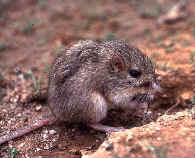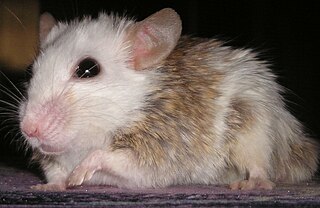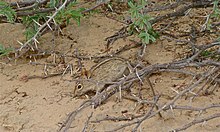
The house mouse is a small mammal of the order Rodentia, characteristically having a pointed snout, large rounded ears, and a long and almost hairless tail. It is one of the most abundant species of the genus Mus. Although a wild animal, the house mouse has benefited significantly from associating with human habitation to the point that truly wild populations are significantly less common than the semi-tame populations near human activity.

The Old World rats and mice, part of the subfamily Murinae in the family Muridae, comprise at least 519 species. Members of this subfamily are called murines. In terms of species richness, this subfamily is larger than all mammal families except the Cricetidae and Muridae, and is larger than all mammal orders except the bats and the remainder of the rodents.

The term spiny mouse refers to any species of rodent within the genus Acomys. Similar in appearance to mice of the genus Mus, spiny mice are small mammals with bare tails which contain osteoderms, a rare feature in mammals. Their coats are endowed with unusually stiff guard hairs similar to the spines of a hedgehog; this trait is the source of the common name, spiny mouse.

Tankwa Karoo National Park is a national park in South Africa. The park lies about 70 km due west of Sutherland and along the border of the Northern Cape and Western Cape in Succulent Karoo habitat; a biodiversity hotspot and one of the most arid regions of South Africa.

The black harrier is a medium-sized African harrier whose range extends from South Africa to Botswana and Namibia. It has a wingspan of 105–115 cm (41–45 in) and a body length of 44–50 cm (17–20 in). When perched, this bird appears all black. However, in flight, a white rump and flight feathers becomes visible. Its morphology is comparable to that of other harriers, with narrow wings, a slim body, and a long tail. Male and female plumages are similar. Juveniles have buff under-parts and heavily spotted breasts.

The desert pocket mouse is a North American species of heteromyid rodent found in the southwestern United States and Mexico. True to its common name, the medium-sized desert pocket mouse prefers sandy, sparsely vegetated desert environments.

The typical striped grass mouse is a small rodent of the suborder Myomorpha in the family Muridae.

Acanthosicyos horridus is an unusual melon that is endemic to the Namib desert. In English it is known as Nara, butter-nuts, or butterpips; in one of the Khoisan languages it is locally called ǃnaras or ǃnara.

The southern multimammate mouse or southern African mastomys is a species of rodent in the family Muridae which is endemic to southern Africa. It is called a multimammate mouse because it can have 8 to 12 pairs of mammae, in comparison other mouse species only have 5 pairs.

The Southern African vlei rat is a species of rodent in the vlei rat genus, Otomys, of the family Muridae in the order Rodentia. This is the type species of the genus. It is native to the grasslands and swamps of southern Africa where it is a common species.

The bush vlei rat or Karoo bush rat is a species of rodent in the family Muridae. It is found in Namibia and South Africa. Its natural habitat is temperate shrubland. The Karoo rat uses behavioral adaptations to cope with the dry arid climate. It is a medium-sized rodent with a dark pelage on top and lighter underneath. It has light colored feet and a dark tail. The rat may have light colored fur around its eyes and the back of its ears.
Littledale's whistling rat is one of two species of murid rodent in the genus Parotomys, the other being Brants's whistling rat. It is found in Namibia and South Africa. Its natural habitats are temperate shrubland, subtropical or tropical dry shrubland, and temperate desert.

The four-striped grass mouse or four-striped grass rat is a species of rodent in the family Muridae.

Nannomys is a subgenus of the rodent genus Mus, the mice. They are known as the African pygmy mice. These species are native to sub-Saharan Africa, where they can be found in many types of habitat. There are 20 species.

Rhabdomys dilectus, the mesic four-striped grass rat, is a species of rodent in the family Muridae.

The ALX3 gene, also known as aristaless-like homeobox 3, is a protein coding gene that provides instructions to build a protein which is a member of the homeobox protein family. This grouping regulates patterns of anatomical development. The gene encodes a nuclear protein that functions as a transcription regulator involved in cell-type differentiation and development.

Arvicanthini is a tribe of muroid rodents in the subfamily Murinae. Almost all recent species in this tribe are or were found in Africa aside from one species, the Indian bush rat, which is found in South Asia and Iran. However, some fossil Golunda species from India and the genus Parapelomys are thought to have also occurred outside Africa, and one species in the fossil genus Saidomys may have also occurred in Afghanistan.
















